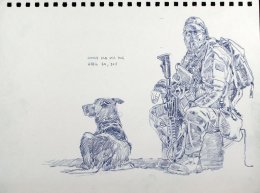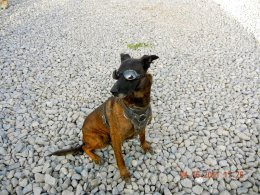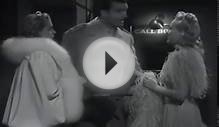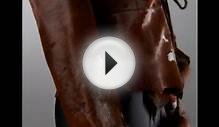
 Meet Fausto and Jimmy. Fausto is a Dutch Shepherd; Jimmy, a former Marine, is his handler. As a team, they are a Contract Working Dog (CWD) and his handler, and they’ve been trained in explosives detection. CWDs aren’t much different from Military Working Dogs (MWDs); they receive similar training, and CWD teams can supplement the work of the MWD teams. As a team, Fausto and Jimmy have saved lives, and Fausto has provided the type of stress relief and morale boosting to the troops that only a dog can give.
Meet Fausto and Jimmy. Fausto is a Dutch Shepherd; Jimmy, a former Marine, is his handler. As a team, they are a Contract Working Dog (CWD) and his handler, and they’ve been trained in explosives detection. CWDs aren’t much different from Military Working Dogs (MWDs); they receive similar training, and CWD teams can supplement the work of the MWD teams. As a team, Fausto and Jimmy have saved lives, and Fausto has provided the type of stress relief and morale boosting to the troops that only a dog can give.
Jimmy and Fausto taking a break. Sketch by Richard Johnson, National Post
Last year, Fausto and Jimmy were in Afghanistan, where they caught the attention of combat artist Richard Johnson. Johnson was there at the behest of the Smithsonian, specifically the Division of Armed Forces History in the National Museum of American History, to document the coalition forces. He did a number of sketches of the soldiers and of the Afghan people. A selection of these sketches is now part of the museum’s military art collection. To find out more about Johnson’s odyssey in Afghanistan, see his blog. He’s currently back in Afghanistan for another tour, sketchbook at the ready, working on this new blog.
 Dogs in the military became a hot topic last year when it was revealed that “Cairo, ” a Belgian Malinois employed by SEAL Team 6, took part in the raid that killed Osama bin Laden. Americans love their dogs (39% of households own at least one dog), so naturally people were curious about these soldiers in fur coats. I was interested in learning what the dogs do, how they are trained, what they eat, and how they are cared for. So I put these questions to Jimmy, who very kindly gave me some answers. My favorite: Jimmy says that he can put a steak next to an explosive and Fausto will step over it to alert to the explosive!
Dogs in the military became a hot topic last year when it was revealed that “Cairo, ” a Belgian Malinois employed by SEAL Team 6, took part in the raid that killed Osama bin Laden. Americans love their dogs (39% of households own at least one dog), so naturally people were curious about these soldiers in fur coats. I was interested in learning what the dogs do, how they are trained, what they eat, and how they are cared for. So I put these questions to Jimmy, who very kindly gave me some answers. My favorite: Jimmy says that he can put a steak next to an explosive and Fausto will step over it to alert to the explosive!
Jimmy and Fausto out on patrol
How is Fausto trained?
Fausto is trained to be obedient to explosive odors, and will ignore other distractions. Training was conducted at North East Police K-9 Academy in Wilkes-Barre, Pennsylvania, with certification from the 341st Training Squadron at Lackland Air Force Base, Texas (where military working dogs and their handlers receive certification), in accordance with the Army regulations AR-190-12.
 What do you feed him?
What do you feed him?
Working dogs get a dry kibble high-energy food as the standard. If the dog has weight issues or allergies, it is fed a special diet. Fausto gets fed twice a day, and yes, he gets treats. He’s kept at 74-76 pounds.
How do you take care of him?
Each dog receives standard vaccinations and others for country-specific health concerns. Daily inspections are conducted for fleas, ticks, and other parasites. Dog handlers are trained in Basic Life Saving Skills for canines: giving IVs; stabilizing fractures; treating gunshot wounds; treating lacerations; taking the dog’s core temperature, and treating the dog for heat and cold-related injuries. Each dog is looked after by the military veterinarians on base.
When is Fausto eligible for retirement?
The mandatory retirement age for Fausto’s line of work is eight years old. Many Military Working Dogs retire by the time they are ten. Upon retirement, dogs are eligible to be adopted by civilians if they are successfully retrained.
But don’t get excited about adopting Fausto. He’ll live out his retirement in Jimmy’s yard, playing catch. He also plans to visit the museum and see his sketch.
Fausto wearing his goggles
The Division of Armed Forces History is interested in collecting artifacts dealing with military working dogs; the only objects we have related to military working dogs are a collar and a shield which belonged to a German Shepherd named Vito, of the Pentagon’s Defense Protective Service Police/K9 Explosives Detection Unit. Vito’s partner was Officer Isaac Ho’opi, who helped save lives on September 11, 2001, when American Airlines Flight 77 crashed into the Pentagon. (Stubby, a famous dog from World War I, was a mascot.) The Army considered dogs to be equipment, and they were treated as such, but that thinking has changed over the years; our thinking here has changed, as well, and we’ve been expanding the scope of our collections. Military working dogs (and contract working dogs) have proven that they are as valuable as their two-legged partners, and deserve recognition.
YOU MIGHT ALSO LIKE










